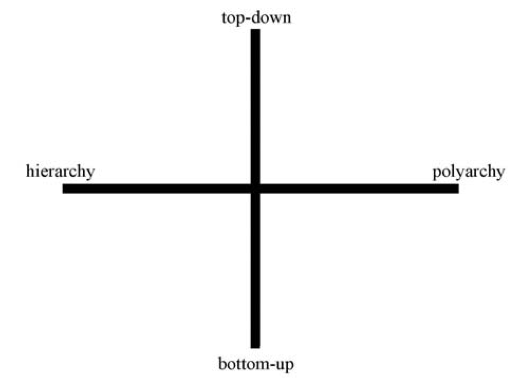Four Quadrants: Difference between revisions
| Line 19: | Line 19: | ||
*'''Hierarchy''': “a system for which there is no alternative, either because it does not exist, because it would be too costly, or because law precludes it.” | *'''Hierarchy''': “a system for which there is no alternative, either because it does not exist, because it would be too costly, or because law precludes it.” | ||
*'''Polyarchy''': being able to choose between multiple regimes or systems. | *'''Polyarchy''': being able to choose between multiple regimes or systems. | ||
'''PROVIDE LINKS TO HOW THESE DEFINITIONS DIFFER FROM TRADITIONAL UNDERSTANDINGS OF THEM.''' | '''PROVIDE LINKS TO HOW THESE DEFINITIONS DIFFER FROM TRADITIONAL UNDERSTANDINGS OF THEM.''' | ||
Revision as of 18:19, 19 December 2010
Introduction
Terms
Definitions
The Four Quadrants
In his article, The Fourth Quadrant, Professor Zittrain develops a four quadrant framework for thinking about the Internet. This framework looks at two criteria: (1) how generative something is, and (2) how singular it is.
The generativity of a phenomena is assessed on a scale from entirely “top-down” to entirely “bottom-up.” The range of singularity runs from “hierarchy” to “polyarchy.” This is captured in the following chart from the article:
Professor Zittrain uses precise (sometimes unconventional) definitions of these terms:
- Top-down: systems in which “there is a separation between those who make the rules and those who live under them . . . .”
- Bottom-up: systems where the rules can come from any person without separation between the people who make the rules and people who live under them.
- Hierarchy: “a system for which there is no alternative, either because it does not exist, because it would be too costly, or because law precludes it.”
- Polyarchy: being able to choose between multiple regimes or systems.
PROVIDE LINKS TO HOW THESE DEFINITIONS DIFFER FROM TRADITIONAL UNDERSTANDINGS OF THEM.
Proposals
This section will summarize the proposals of various cyber security authors. The next section will attempt to map these proposals onto Professor Zittrain's framework.
